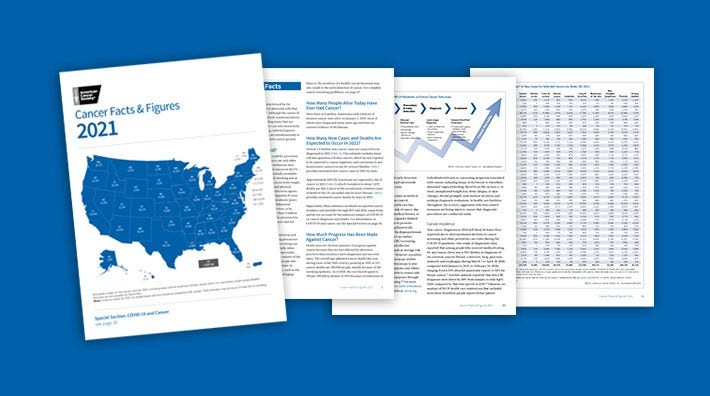Facts & Figures 2021 Reports Another Record-Breaking 1-Year Drop in Cancer Deaths

The death rate from cancer in the United States has continued to decline. From 1991 to 2018, the cancer death rate has fallen 31%. This includes a 2.4% decline from 2017 to 2018 – a new record for the largest one-year drop in the cancer death rate. These are just some of the findings from the annual statistics reported by the American Cancer Society (ACS).
In Cancer Statistics, 2021 and its consumer-friendly companion, Cancer Facts & Figures 2021, ACS researchers estimate that in the US in 2021, almost 1.9 million new cancer cases will be diagnosed. And more than 600,000 people will die from cancer.
These numbers do not account for the effect the COVID-19 pandemic has likely had on cancer diagnoses and deaths because they are projections based on reported cases and deaths through 2017 and 2018, respectively. More details about COVID-19 and its impact on cancer is available in the Cancer Facts & Figures report’s Special Section: COVID-19 and Cancer.
Each year, ACS reports on the most recent facts about cancer in the US. They estimate numbers of new cancer diagnoses and deaths for the current year. These estimates are some of the most widely quoted cancer statistics in the world.
The full article, Cancer Statistics, 2021 was published in CA: A Cancer Journal for Clinicians. The findings are also available in a companion report, Cancer Facts and Figures 2021, and available at the interactive Cancer Statistics Center website.
Cancer death rates continue to go down
The cancer death rate in the US mostly went up during the 20th century. The rise was mainly due to the smoking epidemic.
The cancer death rate hit its peak in 1991, with 215 out of every 100,000 people dying from cancer. Since then, the cancer death rate has steadily gone down – dropping by a total of 31%.
The fastest decline so far was in the last two years. Each year set a record for the largest one-year drop in the cancer death rate – 2.2% from 2016 to 2017 and 2.4% from 2017 to 2018.
Declines in the cancer death rate since 1991 are mainly due to fewer people smoking, but also advances in early detection and treatment for some cancers.
But even with this drop in death rates, cancer is still the second most common cause of death in men and women in the US. Only heart disease kills more people than cancer.
Major cancer types: Lung, breast, prostate, and colorectal cancer
The 27-year decline in the overall cancer death rate is mostly due to long-term drops in the four most common cancers: lung, colorectal, breast, and prostate. Among the largest drop is in lung cancer deaths. In contrast, progress in reducing colorectal and breast cancer deaths has slowed and prostate cancer rates have stayed the same.
These four cancers account for more than four out of every ten cancer deaths in the United States. Almost one-quarter of all cancer deaths are due to lung cancer – more than breast, prostate, and colorectal cancers combined.
Reductions in the lung cancer death rate account for almost half of the total drop in the cancer death rate from 2014 to 2018. Overall declines in the lung cancer death rate are mostly due to reductions in smoking, although improved treatments for non-small cell lung cancer (NSCLC), the most common subtype, appear to have accelerated this progress. Even with these advances, lung cancer is still the second most commonly diagnosed cancer in men and women. More than 80% of lung cancer deaths are due to cigarette smoking.
The death rate from breast cancer dropped by more than 40% from 1989 to 2018 because of earlier detection, through both increased awareness and mammography screening, as well as advances in treatment.
Finding prostate cancer earlier through PSA testing and advances in treatment helped lower the death rate for prostate cancer by about 4% each year from the mid-1990s until about 2013. But more recently (2013-2018), the death rate is no longer dropping.
Death rates from colorectal cancer have dropped by 55% from 1970 to 2018, due to changes in risk factors (like declines in smoking); colorectal cancer screening, which can prevent cancer and find cancer earlier through screening; and better treatments. But death rates are increasing in adults younger than age 55 because of increasing incidence.
Cancer disparities
The American Cancer Society is committed to eliminating disparities in cancer. Cancer disparities are differences in who develops cancer and how well they do after a diagnosis. These differences are closely linked with social, economic, and/or environmental disadvantages and other characteristics historically tied to discrimination or exclusion, including historical and persistent racism. In the US, this has led to differences in socioeconomic status (SES) measured by income, education, work, housing, and health insurance status.
For example, although the five-year relative survival rate has improved greatly for all cancers combined for individuals who are Black and white, it remains substantially lower for those who are Black, 63% versus 68% for diagnoses during 2010-2016. For many cancers, the difference is much larger. Five-year survival is about 20% lower in Black individuals for melanoma and cancers of the uterine corpus (endometrial cancer) and oral cavity.
There is a similar disparity in cancer death rates, although the gap has begun to narrow. In 1993, the cancer death rate was 33% higher among Black people than white people. In 2018, this number had dropped to 13%. This improvement is largely due to a steep drop in smoking by Black teens.
Still, for most cancer types, death rates are higher for Black people. The death rate for Black men with prostate cancer is more than double that of men in every other population. And Black women have a 40% higher breast cancer death rate than white women, even though their diagnoses rates are slightly lower.
Special section: COVID-19 and Cancer
Each year, American Cancer Society researchers include a special section in Cancer Facts & Figures highlighting a specific timely cancer-related topic. This year, the topic is COVID-19 and cancer. The COVID-19 pandemic has caused reduced access to care for other illnesses, including cancer. This has led to delays in cancer screening, diagnosis, and treatment.
Even as access to care improves, people may continue to wait to see their doctors for preventive care or an evaluation of symptoms because they’ve lost their jobs due to COVID-19 (including their work-based health insurance) or are afraid they will expose themselves to the virus. This delayed care is expected to result in a brief drop in cancer diagnoses, followed in the years to come by a rise in late-stage diagnoses and cancer deaths.
Also, habits that can increase cancer risk, such as drinking alcohol, not staying physically active, and weight gain, have increased during the pandemic and may lead to long-term health problems.
We will not know the full impact of the COVID-19 pandemic on future cancer outcomes until nationwide data become available in a few years.
Lives saved
The death rate has decreased for most cancer types. This steady progress is due to fewer people smoking, earlier detection for many types of cancer, and improved cancer treatments. This progress means that there were about 3.2 million fewer cancer deaths from 1991 to 2018.
Other highlights from the report:
Every day in 2018, about 11 women died from cervical cancer in the US, with half of them in their 50s and younger. Cervical cancer also remains the second leading cause of cancer death among women in their 20s and 30s.
Cervical cancer is almost 100% preventable through screening and the HPV vaccine. The US has lower up-to-date HPV vaccination rates than other high-income countries.
Compared to dropping incidence trends for lung and colorectal cancers, the rate of new female breast cancer cases increased by about 0.5% each year from 2008 to 2017, which is thought to be due, in part, to increased obesity rates and decreased fertility rates.
Prostate, lung and bronchus, and colorectal cancers make up 46% of all cancer cases in men, with prostate cancer accounting for 26% of all cancers in men. For women, breast, lung, and colorectal cancers combined make up just over 50% of all new diagnoses, with breast cancer accounting for 30% of all cancers in women.
- Reviewed by
- Citations
- Helpful resources

The American Cancer Society medical and editorial content team
Our team is made up of doctors and oncology certified nurses with deep knowledge of cancer care as well as editors and translators with extensive experience in medical writing.
Cancer Statistics, 2021. Published early online January 12, 2021 in CA Cancer Journal for Clinicians. First author Rebecca L. Siegel, MPH, American Cancer Society, Atlanta, Ga.
Cancer Facts & Figures 2021. Published online January 12, 2021. American Cancer Society, Atlanta, Ga.
American Cancer Society news stories are copyrighted material and are not intended to be used as press releases. For reprint requests, please see our Content Usage Policy.



